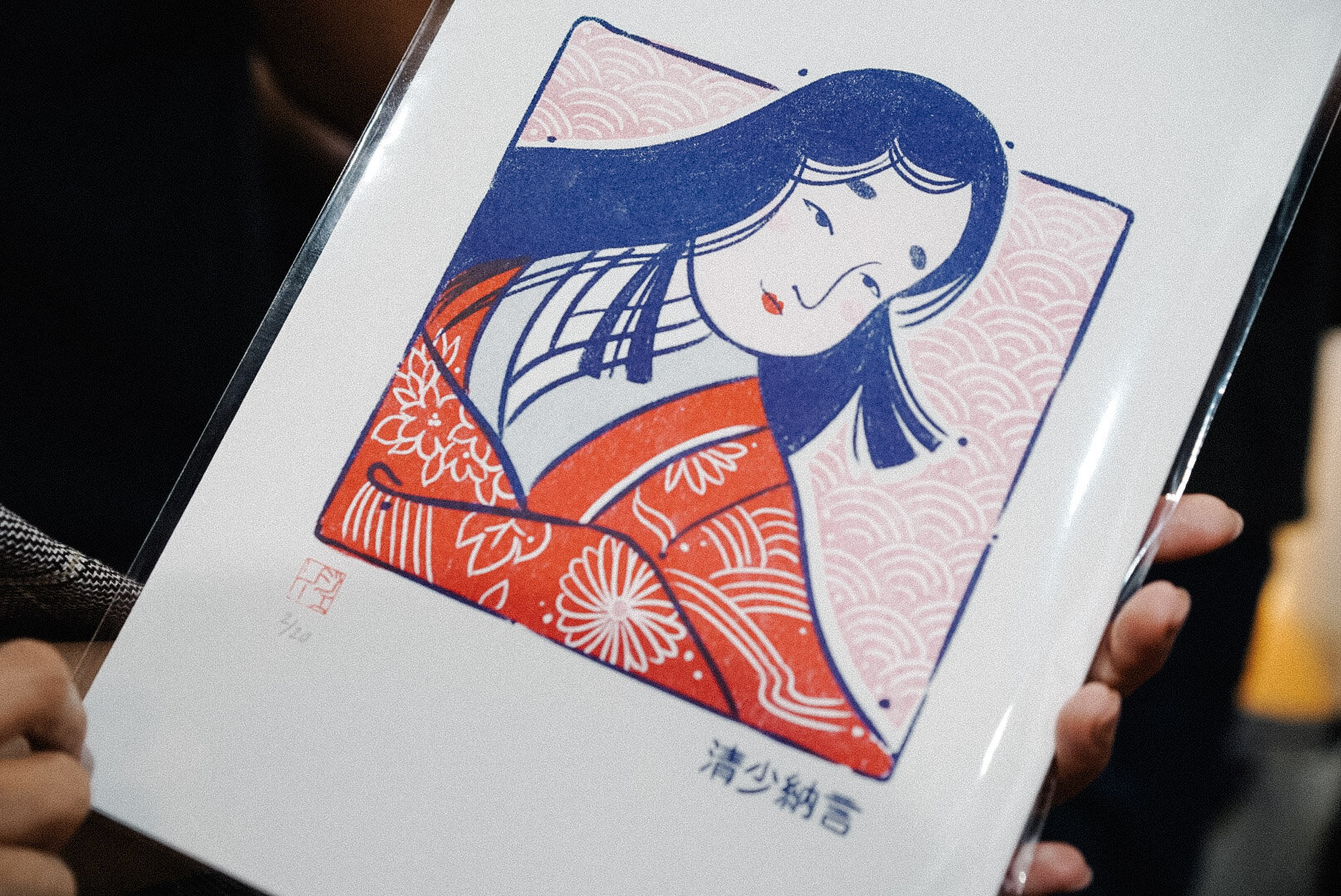 Image 1 of 5
Image 1 of 5

 Image 2 of 5
Image 2 of 5

 Image 3 of 5
Image 3 of 5

 Image 4 of 5
Image 4 of 5

 Image 5 of 5
Image 5 of 5






Higuchi Ichiyo 樋口一葉 - A4 Riso Print (Signed and Numbered)
Higuchi Ichiyo 樋口一葉
First prominent woman writer in modern Japan
近代日本以降では最初の職業女流作家 (1872年5月2日–1896年11月23日)
彼女は作品の中に苦しみに対する意識と鋭い感性をもっており、地位の低い女性の悲惨な状態についてよく書いていました。
Higuchi Ichiyō was the pen name of author Higuchi Natsu, also known as Higuchi Natsuko. Despite living a relatively short life, having died at the age of 24, she became one of the most important writers to appear in the Meiji period. Her stories had such a strong impact on Japanese literature that her influence is still found in Japanese society today.
Higuchi was born in Tokyo after her parents had moved from a farming town in a nearby prefecture. When she was 14, she started studying classical poetry at Haginoya, a poetic conservatory. She took lessons and lectures on literature and entered monthly poetry competitions, but she always felt out of place amongst the other students who came from upper-class families.
Upon seeing a classmate become successful, she was spurred on and decided to write to support her family. She got her first break when her stories were published in a small newspaper. She went on to write Umoregi, a story published in a prestigious journal, just nine months after her decision to write for a living. With this, she officially became the first woman in Japan to make a living from writing alone.
Higuchi had a unique awareness of suffering and sensitivity in her writing and often touched on the topics of the plight of women in lower classes. The last of her stories spread her fame far and wide, but sadly, she passed away from tuberculosis at just age 24, as her father and brother had before her. Today, her likeness appears on the 5000 yen banknote and is the second woman to be depicted, after Empress Jingu and Murasaki Shikibu.
What is a riso print?
These prints use risograph technology, a method of printing developed in Japan in the mid-1980s. It can be described as a mix between screenprinting and photocopying. The risograph process produces prints with extremely vibrant, crisp inks, and sometimes these inks overlap during the printing process to create interesting and unique details. These soy-based inks also have a lower environmental impact.
Product details
Printed in Tokyo, Japan by Hand Saw Press print studio. Each print is A4 size (210 x 297 mm / 8.27 x 11.69 in) and printed on Natural White 186gsm Takeo Araveal paper. Acid-free and FSC Approved.
Each print is signed with a traditional Japanese ‘hanko’ artist stamp and hand-numbered from a limited edition of 20. Prints are packaged in cello bags with rigid cardboard inserts and shipped in flat mailers.
Please note that frames are not included.
Delivery times & prices
We ship worldwide. 日本へ国際郵便で送ります。
UK deliveries: 3-4 working days via Royal Mail 1st class
International deliveries available via Royal Mail International Standard Airmail
Prices calculated during checkout
For more information on shipping times for international deliveries, please check the delivery & returns page.
Higuchi Ichiyo 樋口一葉
First prominent woman writer in modern Japan
近代日本以降では最初の職業女流作家 (1872年5月2日–1896年11月23日)
彼女は作品の中に苦しみに対する意識と鋭い感性をもっており、地位の低い女性の悲惨な状態についてよく書いていました。
Higuchi Ichiyō was the pen name of author Higuchi Natsu, also known as Higuchi Natsuko. Despite living a relatively short life, having died at the age of 24, she became one of the most important writers to appear in the Meiji period. Her stories had such a strong impact on Japanese literature that her influence is still found in Japanese society today.
Higuchi was born in Tokyo after her parents had moved from a farming town in a nearby prefecture. When she was 14, she started studying classical poetry at Haginoya, a poetic conservatory. She took lessons and lectures on literature and entered monthly poetry competitions, but she always felt out of place amongst the other students who came from upper-class families.
Upon seeing a classmate become successful, she was spurred on and decided to write to support her family. She got her first break when her stories were published in a small newspaper. She went on to write Umoregi, a story published in a prestigious journal, just nine months after her decision to write for a living. With this, she officially became the first woman in Japan to make a living from writing alone.
Higuchi had a unique awareness of suffering and sensitivity in her writing and often touched on the topics of the plight of women in lower classes. The last of her stories spread her fame far and wide, but sadly, she passed away from tuberculosis at just age 24, as her father and brother had before her. Today, her likeness appears on the 5000 yen banknote and is the second woman to be depicted, after Empress Jingu and Murasaki Shikibu.
What is a riso print?
These prints use risograph technology, a method of printing developed in Japan in the mid-1980s. It can be described as a mix between screenprinting and photocopying. The risograph process produces prints with extremely vibrant, crisp inks, and sometimes these inks overlap during the printing process to create interesting and unique details. These soy-based inks also have a lower environmental impact.
Product details
Printed in Tokyo, Japan by Hand Saw Press print studio. Each print is A4 size (210 x 297 mm / 8.27 x 11.69 in) and printed on Natural White 186gsm Takeo Araveal paper. Acid-free and FSC Approved.
Each print is signed with a traditional Japanese ‘hanko’ artist stamp and hand-numbered from a limited edition of 20. Prints are packaged in cello bags with rigid cardboard inserts and shipped in flat mailers.
Please note that frames are not included.
Delivery times & prices
We ship worldwide. 日本へ国際郵便で送ります。
UK deliveries: 3-4 working days via Royal Mail 1st class
International deliveries available via Royal Mail International Standard Airmail
Prices calculated during checkout
For more information on shipping times for international deliveries, please check the delivery & returns page.
Higuchi Ichiyo 樋口一葉
First prominent woman writer in modern Japan
近代日本以降では最初の職業女流作家 (1872年5月2日–1896年11月23日)
彼女は作品の中に苦しみに対する意識と鋭い感性をもっており、地位の低い女性の悲惨な状態についてよく書いていました。
Higuchi Ichiyō was the pen name of author Higuchi Natsu, also known as Higuchi Natsuko. Despite living a relatively short life, having died at the age of 24, she became one of the most important writers to appear in the Meiji period. Her stories had such a strong impact on Japanese literature that her influence is still found in Japanese society today.
Higuchi was born in Tokyo after her parents had moved from a farming town in a nearby prefecture. When she was 14, she started studying classical poetry at Haginoya, a poetic conservatory. She took lessons and lectures on literature and entered monthly poetry competitions, but she always felt out of place amongst the other students who came from upper-class families.
Upon seeing a classmate become successful, she was spurred on and decided to write to support her family. She got her first break when her stories were published in a small newspaper. She went on to write Umoregi, a story published in a prestigious journal, just nine months after her decision to write for a living. With this, she officially became the first woman in Japan to make a living from writing alone.
Higuchi had a unique awareness of suffering and sensitivity in her writing and often touched on the topics of the plight of women in lower classes. The last of her stories spread her fame far and wide, but sadly, she passed away from tuberculosis at just age 24, as her father and brother had before her. Today, her likeness appears on the 5000 yen banknote and is the second woman to be depicted, after Empress Jingu and Murasaki Shikibu.
What is a riso print?
These prints use risograph technology, a method of printing developed in Japan in the mid-1980s. It can be described as a mix between screenprinting and photocopying. The risograph process produces prints with extremely vibrant, crisp inks, and sometimes these inks overlap during the printing process to create interesting and unique details. These soy-based inks also have a lower environmental impact.
Product details
Printed in Tokyo, Japan by Hand Saw Press print studio. Each print is A4 size (210 x 297 mm / 8.27 x 11.69 in) and printed on Natural White 186gsm Takeo Araveal paper. Acid-free and FSC Approved.
Each print is signed with a traditional Japanese ‘hanko’ artist stamp and hand-numbered from a limited edition of 20. Prints are packaged in cello bags with rigid cardboard inserts and shipped in flat mailers.
Please note that frames are not included.
Delivery times & prices
We ship worldwide. 日本へ国際郵便で送ります。
UK deliveries: 3-4 working days via Royal Mail 1st class
International deliveries available via Royal Mail International Standard Airmail
Prices calculated during checkout
For more information on shipping times for international deliveries, please check the delivery & returns page.





